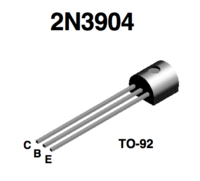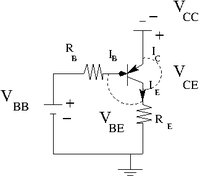Difference between revisions of "Lab 13 TF EIM"
| Line 54: | Line 54: | ||
{| border="1" |cellpadding="20" cellspacing="0 | {| border="1" |cellpadding="20" cellspacing="0 | ||
|- | |- | ||
| − | |V_{CC} || V_B || V_{BB} || V_ E || R_E || R_B || I_E || I_B | + | |V_{CC} || V_B || V_{BB} || V_ {EC} || V_ E || R_E || R_B || I_E || I_B |
|- | |- | ||
| − | |mV || mV || V || mV || <math>\Omega</math> || k<math>\Omega</math>|| mA|| \muA | + | |mV || mV || V || mV || mV || <math>\Omega</math> || k<math>\Omega</math>|| mA|| \muA |
|- | |- | ||
| − | | || || || || || || || | + | | || || || || || || || || |
|} | |} | ||
| Line 68: | Line 68: | ||
{| border="1" |cellpadding="20" cellspacing="0 | {| border="1" |cellpadding="20" cellspacing="0 | ||
|- | |- | ||
| − | |V_{CC} || V_B || V_{BB} || V_ E || R_E || R_B || I_E || I_B | + | |V_{CC} || V_B || V_{BB} || V_ {EC} || V_ E || R_E || R_B || I_E || I_B |
|- | |- | ||
| − | |mV || mV || V || mV || <math>\Omega</math> || k<math>\Omega</math>|| mA|| \muA | + | |mV || mV || V || mV || mV || <math>\Omega</math> || k<math>\Omega</math>|| mA|| \muA |
|- | |- | ||
| − | | || || || || || || || | + | | || || || || || || || || |
|} | |} | ||
| + | |||
Revision as of 01:52, 9 March 2011
DC Bipolar Transistor Curves
Data sheet for transistors.
Media:2N3904.pdfMedia:2N3906.pdf
Using 2N3904 is more srtaight forward in this lab.
Transistor circuit
1.) Identify the type (n-p-n or p-n-p) of transistor you are using and fill in the following specifications.
| Value | Description |
| Collector-Base breakdown voltage | |
| Emitter-Base Breakdown Voltage | |
| Maximum Collector Voltage | |
| Maximum Collector Current | |
| Transistor Power rating() | |
| DC current gain |
2.) Construct the circuit below according to the type of transistor you have.
Let .
variable power supply
.
Find the resistors you need to have
, , and
3.) Measure the emitter current for several values of by changing such that the base current A is constant.
| V_{CC} | V_B | V_{BB} | V_ {EC} | V_ E | R_E | R_B | I_E | I_B |
| mV | mV | V | mV | mV | k | mA | \muA | |
4.) Repeat the previous measurements for A. Remember to keep so the transistor doesn't burn out
| V_{CC} | V_B | V_{BB} | V_ {EC} | V_ E | R_E | R_B | I_E | I_B |
| mV | mV | V | mV | mV | k | mA | \muA | |
5.) Graph -vs- for each value of and above. (40 pnts)
6.) Overlay points from the transistor's data sheet on the graph in part 5.).(10 pnts)
Questions
- Compare your measured value of or for the transistor to the spec sheet? (10 pnts)
- What is for the transistor?(10 pnts)
- The base must always be more _________(________) than the emitter for a npn (pnp)transistor to conduct I_C.(10 pnts)
- For a transistor to conduct I_C the base-emitter junction must be ___________ biased.(10 pnts)
- For a transistor to conduct I_C the collector-base junction must be ___________ biased.(10 pnts)



